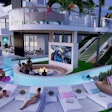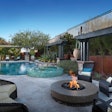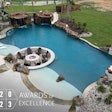
When it comes to what is and isn’t desirable aquatic design, there is no shortage of opinion amongst both professionals and consumers. Fact is, water in the landscape generates an emotional response in many and that power of deep appeal often leads to extremely strong ideas about the design of water systems. For example, we’ve seen everything from pools shaped like guitars to lush lagoon-style settings, formal designs that look like something straight out of Versailles, crisp contemporary compositions with edges that appear sharp enough to shave with, and others with sensuous curves that suggest various body parts.
In my work covering this industry, I’ve seen pools that qualify as genuine works of sculptural and architectural art, beautifully designed and built by gifted artists for clients of impeccable taste. And then there are those that look something out of a bawdy theme park. I’ve seen giant skulls made out of artificial rock, a half-scale pirate ship fashioned in fiberglass, dinosaur fossils embedded in pool decks and faux giant sandcastles perched on coping. If it can be imagined, somewhere somebody is going to be willing to pay for it in their backyard.
Although there are no entirely clear-cut lines, there is a dichotomy in all of this. Whimsy and creativity are on one side of the coin, but on the other side of the coin there are those projects that seem to replace artistic spark with inane excess or just obviously lousy design sensibility. (At least to my eye, the pirate ship was a genuinely bad design choice.)
Lately I’ve had a number of conversations with designers and builders who have expressed frustration over clients who want things that are just flat-out ugly. Just recently, in fact, I received a call from Scott Cohen, owner and principle designer of the Green Scene, a landscape design and construction firm based in Southern California. Scott called suggesting that I write a blog about handling clients with bad taste.
He’d recently been confronted by a client who insisted on a particularly ugly tile. “It was pretty amazing,” he said, “I was dealing with a couple and the wife wanted to include a tile pattern that was so hideous I found it hard to believe the product even existed. I tried my best to explain why it was such a bad choice, but she absolutely insisted. So, we’re going to put it in and give her what she wants. I don’t feel good about it, getting paid to basically destroy an otherwise nice design, but . . . ”
As Scott went on to lament, clients presumably choose designers because they want the background, skill set, talent and ultimately the opinion of someone who has experience creating quality exterior environments. “Most of the time,” says Cohen, “clients recognize that you have more knowledge than they do and they’ll gladly take your advice. But what do you do when run into one that just refuses and makes a choice the mars the appearance?”
Scott and others I’ve spoken with on this thorny subject say they do acknowledge that beauty is in the eye of the beholder and that the customer is boss (two other examples of enduring clichés), but often, as Cohen points out, “Clients don’t know what they want because they don’t have the frames of reference in terms of design. We’re hired to imagine on their behalf.”
When that process breaks down, you’re left with the difficult judgment call as to how far to bend. In some cases, Cohen and others will tell the client that their project won’t be featured in the company’s portfolio, a fairly gentle response, and in extreme situations where communications completely break down, walking away from the project can be an option.
“We are ultimately here to make the client happy and that does mean working with whatever their taste might be, good or bad,” he says. “I’m certainly not opposed to doing unusual things. I once made a spa that looks like a martini glass and I’ve used wine bottles to make bars and waterfalls. The keys to success were those features fit in with the clients’ personalities and their homes.”
And therein lie the tough questions: What is it that makes taste good or bad? When does a fun idea become misguided? And ultimately, how far do you go to make the client happy, even if their idea of beautiful is a giant sore thumb?








































